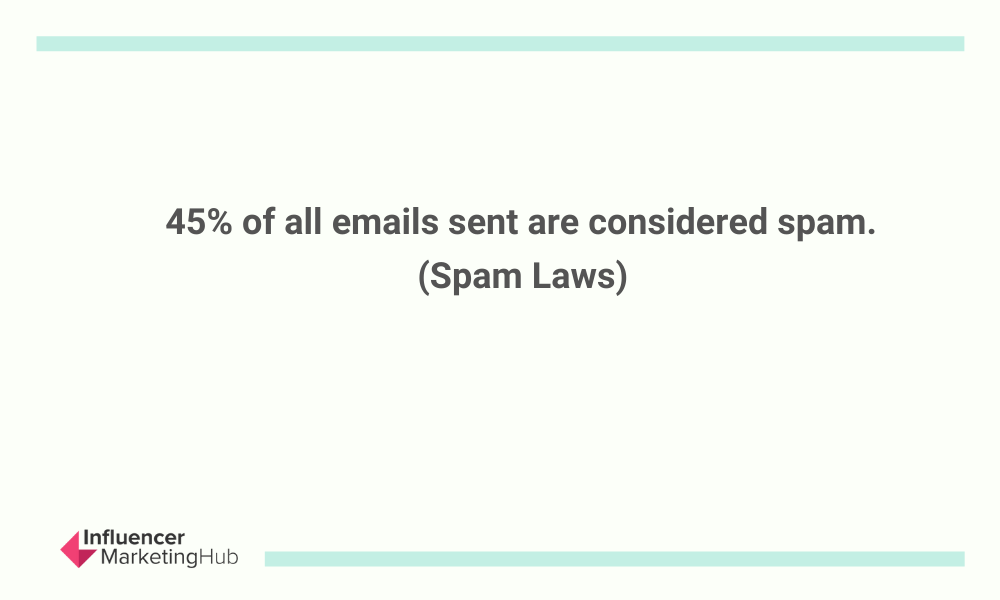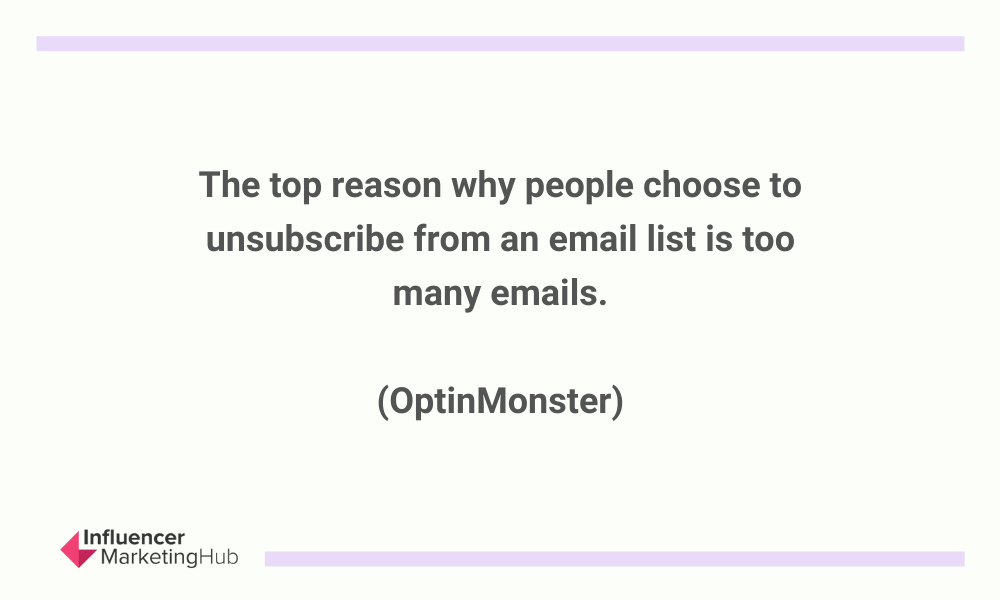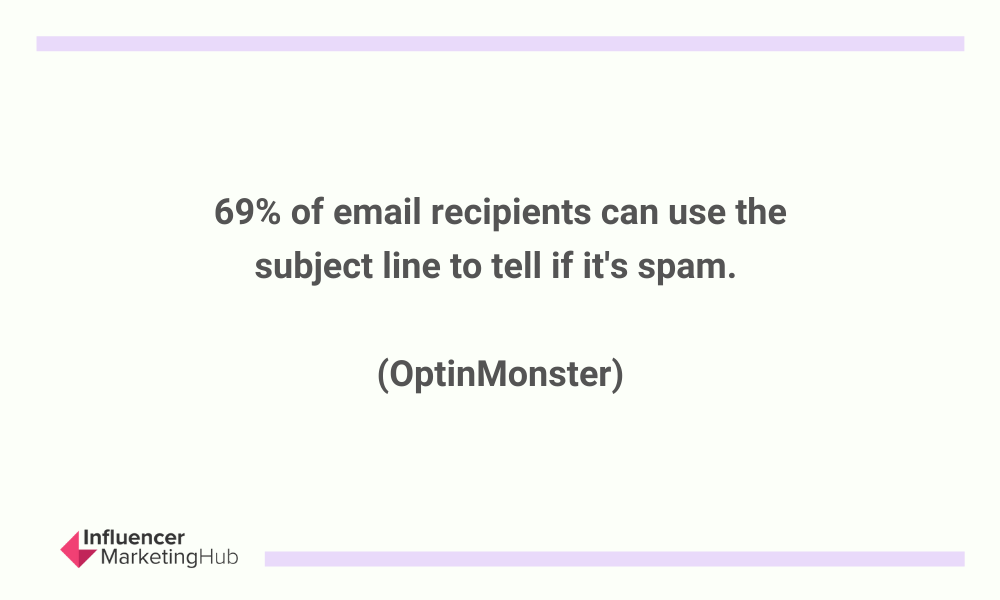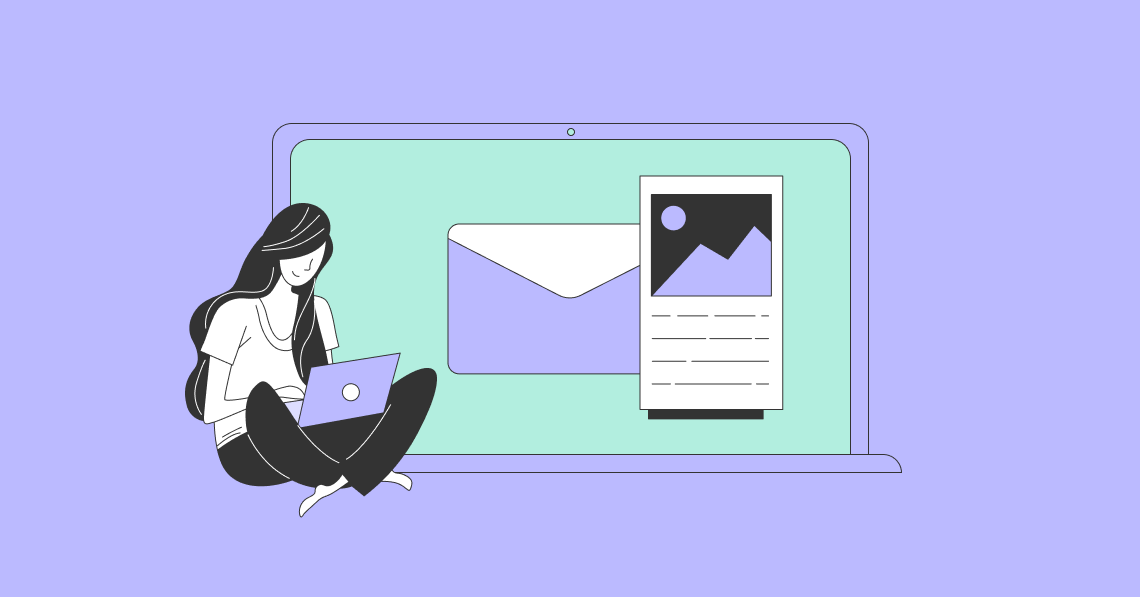随着去把握ay season approaches, it’s not only spending that increases, but also the sending of emails. After all, ‘tis the season of giving and what’s better than receiving yet another promotional email in your inbox, right?
A lot.
当营销人员开始更频繁地发送电子邮件this time of the year, email deliverability becomes an issue. Not only can the frequency cause email deliverability issues, but also the contact list. If you haven’t recently removed inactive subscribers from your list, it could hurt deliverability. To help you make the most of this important period on the marketing calendar, here are some tips and best practices for preventing spam complaints.
9 Email Delivery Tips for Skipping the Spam Folder
- 1. Start early
- 2. Increase your volume gradually
- 3. Remove inactive subscribers
- 4. Use a sign-up form
- 5. Make it easy to unsubscribe
- 6. Guard against information overload
- 7. Create content that keep the ISPs happy
- 8. Pay attention to your sender reputation
- 9. Use a professional business address
- Frequently Asked Questions
What’s Email Deliverability?

As the phrase suggests, email deliverability refers to the ability to deliver emails to your subscribers’ inboxes. It’s often used by email marketers to determine how many emails were actually delivered and work out the bounce rate (in other words, how many couldn’t be delivered because of a temporary error or a permanent error like an invalid email address).
Though, it’s important to note that the percentage can be deceiving. Mails that end up in the spam folder count as being delivered. So, it’s better to focus rather on where it gets delivered.
So far, it sounds pretty straightforward and self-explanatory. There’s you (the legitimate email sender) and the recipients (your subscribers). However, there’s also a third party that’s working tirelessly behind the screens and scenes – the gateways. These are the companies, like internet service providers (ISPs) and anti-spam systems, that control if your messages get delivered and make it possible for you to send mass emails.
You see, these ISPs also have to play the role of a cop, because not all senders are legitimate. They need to protect email users from spammers who send unsolicited emails, often with malicious links, to loads of people. From sending limits to two-day blocks to blacklisting, there are various ways these ISPs can impact email deliverability.
Now that you have a better understanding of the hidden process involved in sending emails, the following tips for improving email deliverability, particularly during the holiday season, will make more sense.
Hard Bounces Vs. Soft Bounces
If you read about email deliverability, you’ll come across a number of technical terms. Two terms that are used often are hard bounce and soft bounce. While email marketing can be sports, the only connection that these terms have to sport is that it’s one mistake and you’re out of the inbox.
A hard bounce refers to when you send an email message to an email address that doesn’t exist. It could be that the user used a fake email address to get their hands on your lead magnet. If that’s not the case, it could be that they’ve changed email providers. Whichever the reason, these email addresses shouldn’t be on your subscriber list as they’ll only negatively impact your deliverability score.
A soft bounce, on the other hand, happens when the mailbox is full (that still happens in this day and age), or, more commonly, the subscriber has set up an auto-reply. Unlike hard bounces, this issue isn’t permanent. So, there’s no need at this stage to delete the email address. However, if the problem persists, it’s best to delete this address.
According to Campaign Monitor, the benchmark for email bounces is about 2%. If your bounce rate is higher than 2%, it can be an indication that something is wrong.
9 Ways to Improve Deliverability
1. Start early
Behind your email provider, there are human faces too. This time of the year they have to deal with high email volume and if there’s a problem with deliverability, it can take longer than normal to fix the issue.
As there’s the possibility that your server might be overloaded with emails on days like Black Friday, Small Business Saturday, Cyber Monday, and the weeks prior to Christmas, it’s best not to keep all of your
holiday email marketingfor these dates. As a matter of fact, data shared by Criteo reveals that retail traffic already starts to increase significantly 10 days before Black Friday. So, it’s not just for the sake of email deliverability that you should plan ahead. If you start with your marketing early, there are ready-to-buy shoppers waiting for you.
2. Increase your volume gradually

If you’ve only been sending emails to your active recipients till now, don’t start to email your entire subscriber list all of a sudden. Instead, you should rather increase the volume slowly each time you send your next batch of messages.
If there’s a sudden huge increase in the number of mails that you send in a campaign, the ISPs will flag it as suspicious. This could mean that your emails get rerouted to the spam folder instead of the inbox. Not only can the response time of support teams be slower this time of the year, but spam filters can also be stricter. So, it’s something important to consider.
It’s recommended that you don’t increase your volume by more than 25% of the volume that you’ve been sending for the past 14 days. If you have a good rep with your provider, you could increase your volume a bit more aggressively, but considering what’s at stake, it’s best to err on the side of caution.
3. Remove inactive subscribers
We know that you probably don’t want to hear it, but sometimes it’s better to let go. A clean list is better than a large list. Sending emails to inactive subscribers can result in high bounce rates. If the email address is no longer in use, there’s also the risk of getting flagged as spam. Neither is good for deliverability.
Though, before you simply delete them from your list, it’s a good idea to send inactive subscribers an email with the aim of bringing them back into the action and encouraging them to start engaging with your brand again. In any case, it’s best practice not to include subscribers in your email marketing campaigns to whom you haven’t sent an email in over six months.
When you’re sending this type of win-back email, you should also keep the volume in mind. According to Mailjet, it’s best to restrict it to a maximum of 10% of your daily email volume.
4. Use a sign-up form
So far, the focus has been on how to manage your subscriber list. Though, how you get your subscribers are equally important. To put it in simple terms, everything begins with your subscriber list. Even if you deliver the most beautiful, valuable, relevant content, but you have not put in the same effort for getting engaged subscribers, your email deliverability will still suffer.
得到用户的最好办法是使用一个opt-in permission approach by using sign-up forms that include an opt-in checkbox. Never use email addresses that have been scraped or bought! You’ll only waste your money and create more problems for your brand.
That being said, while you can use an incentive, like a competition, with your sign-up forms (and it’s a strategy that’s common practice), these types of forms often lead to high bounce rates too. Typically, these users will share a fake email address or one that they never check just to get access to your offer which can lead to more hard bounces.
If you’re going to offer a type of reward for signing up, the secret is to make sure that the content that you’ll be sharing moving forward is just as good as the incentive (if not better). Also, make sure that you include an opt-in checkbox and be upfront about the type of content that they’ll be receiving if they do opt in.
It’s even better if you can use a double opt-in. With this strategy, everyone who signed up will first have to activate their subscription by means of a confirmation email. Not only will it help you to eliminate fake email addresses from the start, but it will also help you to attract more active and engaged subscribers.
5. Make it easy to unsubscribe
This might not be your favorite piece of advice, but if you don’t want your deliverability to suffer you’ll need to ensure that subscribers can unsubscribe with the click of a button. Before you start to worry that you’ll be opening a Pandora’s box, the average unsubscribe rate is extremely low. On average, not even 1% of subscribers decide to unsubscribe. So, possibly losing only a fraction of your subscribers is much better than running the risk that users will report you as spam.
Without making it more difficult for subscribers to unsubscribe, you can, for example, add a short poll. This way you’ll be able to get to the actual reason why people are choosing to unsubscribe and you can then use this data to adjust the frequency or improve the content if needed.
6. Guard against information overload
Inbox fatigue is a real thing and it’s for sure not the way you want your audience to end their year. If you usually email your subscribers only every other week and all of a sudden increase it to once every day, similarly to the ISPs, your subscribers too won’t be impressed by this new schedule. Fortunately for your readers (but unfortunately for you), it’s one of the easiest annoyances to sort out. They don’t have to open your emails or can simply unsubscribe altogether.
We’re not saying that you should stick to your regular schedule during this time of the year, but just make sure that whatever you’re sending will be relevant content that offers value to your recipients. Too often marketers fall into the trap of sending an email just for the sake of sending it.
7. Create content that keep the ISPs happy

The actual email content can also make the ISPs suspicious and fool them into thinking that you’re a spammer. Most of these triggers have to do with your subject line.
Firstly, yoursubject linesshouldn’t be longer than 50 characters. Then, with regards to the actual wording, you need to avoid spammy words like free, cash, and limited-time offer. Using all caps is also a NO in capital letters. This applies to the body of your email message as well. And, while it might sound counterintuitive, remember to include an unsubscribe link in every email.
With regards toembedding images, you’re welcome to do this. Though, it should be mostly text. It’s recommended that you stick to a text-to-image ratio of 6:4.
8. Pay attention to your sender reputation
Your sender reputation also plays a role in email deliverability, however, unlike most of the other tips discussed already, you have less control over this. Firstly, your sender reputation isn’t static. For instance, if you send loads of email to a group that’s less engaged, it can negatively impact your reputation temporarily. In order for your messages to end up in the inboxes of your email list, you need to have an average or good reputation. This is the sum of your domain reputation and IP reputation.
Knowing the more in-depth technical details aren’t important, what is important is to segment your email lists. It’s one of the easiest ways to improve your sender reputation. You’ve probably/hopefully been segmenting your lists already using factors like age, demographics, location, gender, interests, etc. Another way to segment your list is by using how recently a subscriber has joined your list and what their engagement has been like thus far.
Those who have joined your list within the last month can be emailed more frequently. Usually, they’re still active and you can create a series of emails to welcome and onboard them. For this group, you can send as many as three emails per week.
On the other hand, subscribers who have joined in the past three months but haven’t opened any emails or clicked on any links shouldn’t be emailed more than once per week. However, as they’ve joined only recently, there’s still hope that they’ll start to engage with your content. So, feel free to continue emailing them on a weekly basis.
9. Use a professional business address
A joint survey conducted by Fluent and Litmus indicated that over 40% of users first look at the sender’s email address before deciding if they should open the message. As there’s no in-person interaction between any of the parties involved in the process, you’ll have to depend on your address to communicate that you’re a reputable, trustworthy sender. Even if your subject line sounds legit but your email address sounds off, recipients and spam filters will grow suspicious.
For this reason, you should never send from an address that’s not the same as your domain. Using free domains like Gmail, Yahoo, or Hotmail, is also not going to work if you’ll be sending mass emails.
You can, for example, use the word “newsletters” together with your domain name. This way, recipients will be able to distinguish your promotional messages from other communication like accounts.
Whatever you do, keep it consistent and customary. Also, while this type of content will most of the time be a one-way conversation, it’s best not to use a no-reply account. No-reply email addresses are simply less credible.
Are There Any Laws About Email Marketing?
At the end of the day, it’s not just about deliverability. It’s also about staying legal. If you didn’t know, there are actually a couple of different laws that apply to how email marketing can be used for commercial purposes. What’s more, failure to comply might even result in fines.
That being said, if your business has implemented the strategies that we’ve discussed and you use a well-known email marketing tool, you’ve most likely not broken any laws. These regulations are mostly aimed at spammers and to prevent businesses from sending users unsolicited emails. As these laws differ from one country to the next, it’s best that you check the rules that apply to your specific region to ensure you haven’t violated any email marketing laws.
Wrapping Things Up
Email remains one of the most relevant and lucrative digital marketing tools. However, you can only reap the benefits that this medium has to offer if your emails get delivered, more specifically to the inboxes of the intended recipients. Plus, considering how many resources go into writing and designing an email, it’s crucial that you do everything in your power to improve deliverability.
The good news is that you can control most things that can impact your email deliverability rate. Frequency can be dialed up or down, subject lines can be shortened, and content can be tweaked.
知道期间发送的电子邮件数量holiday season are drastically more, it’s also key that you plan ahead and start your email campaigns early. Not only will you be surprised to know that your customers might be ready for your holiday emails before you think, but it will also prevent you from relying only on peak periods when ISPs might not be able to respond as quickly to issues with email delivery.
Frequently Asked Questions
Are there any alternative holidays that you can include in your email marketing?
It’s important that your email marketing focuses on the major shopping events on the calendar like Black Friday, Cyber Monday, and Christmas, but there are also alternative days that you can target. You can, for example, also promote GivingTuesday. In the US, GivingTuesday (aka #GivingTuesday) is the Tuesday after Thanksgiving. The goal of this day is to get individuals and businesses to change their communities and the world by good deeds. This way, you can also appeal to a bigger audience.
What’s the average unsubscribe rate?
Luckily, the average unsubscribe rate is very low – less than 1%! GetResponse and Campaign Monitor estimates that the average unsubscribe rate is 0.10 - 0.12%, while Sendinblue calculate is at merely 0.05%. To work out your unsubscribe rate, you need to divide the number of subscribers who unsubscribed by the number of emails delivered and multiply the answer by 100.
What are some tips for creating a professional email address?
When you’re creating a business address, it’s best not to use a free Gmail or Yahoo address. Instead, you should use a customized email address that ideally uses the same domain name as your business website. It’s also better to stick to a standard format and use something that’s easy to pronounce and short. Lastly, you should remember to adjust your display name. Sometimes it will be better to use your personal name, while other times the company name will be more appropriate.
How can you prevent your email address from getting blacklisted?
If your IP address is on a blacklist, your marketing emails won’t get delivered to their intended recipients. Instead, they’ll either go straight to the spam folder or not get delivered at all. To avoid this from happening, you should:
- Use a reputable email marketing service
- Use an opt-in email strategy
- Keep your email list clean and ensure it’s up to date
- Never add anyone to your email subscriber list without permission
你能使用不回答电子邮件地址吗?
While you can, it’s not a good idea. For starters, it will hurt your email deliverability and open rates. On top of that, it also creates poor engagement. After all, the purpose of email is to communicate with your potential customers.




